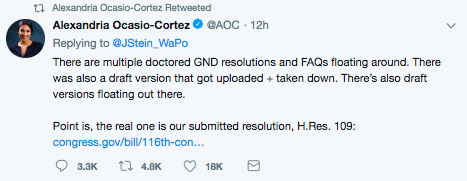As you can see from the interview by Tucker Carlson on Fox, there has been some confusion and even disinformation about what is IN and what is not in the Green New Deal (GND) bill, H.R. 109. We summarize it for you here. First, it is a resolution, not a law, and its purpose is to provide principles and a framework for a set of specific new laws that would be direct government and the private sector to take actions.
The first section contains a list of reasons why the GND is needed that spans both environmental and economic concerns, including the fact that a significant part of the population in the U.S. does not have access to clean air, clean water, affordable healthcare, and a good job. At the same time, it recognizes many of the climate challenges we face, including $500,000,000,000 in lost annual economic output in the United States by the year 2100, and it calls out the vast wage disparity in the U.S.
It then states that it is the “duty” of the government to create a GND with five goals:
- net-zero greenhouse gas emissions through a fair and just transition for all communities and workers
- create millions of good, high-wage jobs and ensure prosperity and economic security
- invest in the infrastructure and industry to sustainably meet the challenges of the 21st century
- secure clean air and water, climate and community resilience, healthy food, access to nature, and a sustainable environment
- promote justice and equity by ending and preventing “historic oppression” of “frontline and vulnerable communities“
Frontline and vulnerable communities are loosely defined as indigenous peoples, communities of color, migrant communities, deindustrialized communities, depopulated rural communities, the poor, low-income workers, women, the elderly, the unhoused, people with disabilities, and youth.
The five GND goals are to be accomplished through projects and spending over a “10-year mobilization” across all sectors of the economy and society to do the following: (1) build resiliency against climate change-related disasters; (2) repair and uprade existing infrastructure to reduce climate impacts, by eliminating pollution and greenhouse gas emissions, and by guaranteeing access to clean water; (3) achieve 100% clean, renewable power; (4) build smart grids and create energy efficiency and access to affordable power; (5) upgrade buildings and future construction to be energy and water efficient, safe and affordable; (6) remove pollution and greenhouse gas emissions from manufacturing and industry as much as is technologically feasible and using renewable energy; (7) work with farmers and ranchers to remove greenhouse gas emissions and other pollution, promote soil health, and to save family farms; (8) overhaul transportation systems to remove pollution, greenhouse gas emissions, improve public transportation and increase zero-emission cars; (9) mitigate the long term effects of pollution and climate change by giving grants to communities; (10) restore ecosystems through projects that enhance resiliency; (11) clean up hazardous waste sites; (12) reduce or eliminate any other pollution; and (13) make the U.S. a leader in green tech and climate action.
Finally, the bill spells out that the process for creating the GND must be inclusive, must be either publicly financed or financed in ways that leverage public funding, includes training and education assistance, particularly for frontline and vulnerable communities, so that people will be able to get GND related jobs, creates good jobs, strengthens the rights of workers against discrimination and unfair labor practices, ends the practice of outsourcing jobs that pollute other countries, ensures that federal lands and oceans are not polluted, that eminent domain is not abused by government. and protects small businesses against large corporations and monopolies. It ends with a catch-all statement of what ultimately the GND would provide all Americans: (1) high-quality health care; (2) affordable, safe, and adequate housing; (3) economic security; and (4) clean water, clean air, healthy and affordable food, and access to nature.
Why This Matters: There will be lots of debate and discussion going forward about how to achieve these very lofty goals. Many will label this “socialism” or falsely claim that the GND will take away cars or pay people even if they are not willing to work. But there is a reason why so many Democrats have already lined up behind it — it has a very strong populist appeal to a wide swath of communities — urban and rural — who feel left behind by the elites. The GND resolution is bold and ambitious enough to meet the challenges we face in this century due to climate change. And the GND firmly ties our future economic prosperity to sustainable development.
To Go Deeper: Read the entire 7 page resolution here. And check out this excellent analysis by Vox. And for another point of view, check out Ross Douthat’s critique of it here.

February 11, 2019 » affordable healthcare, affordable housing, clean air, clean energy, clean water, climate change, GND, Green New Deal, greenhouse gas emissions, income inequality, Infrastructure, pollution, renewable energy, resilience


